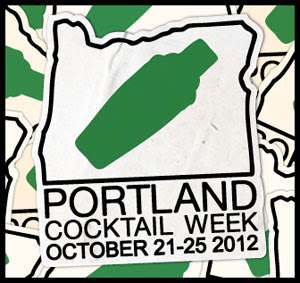 The second talk I went to on Monday at Portland Cocktail week was given by Jennifer Colliau of Small Hand Foods. Jennifer started off by discussing the Mai Tai to provide a background of why she got interested in making syrups. She had gotten into an argument with another bartender back in the day about what the nutty ingredient in the drink was -- amaretto or crème de noyeau. Her research turned up that it was neither of those two liqueurs but orgeat syrup, and her taste testing found that all orgeat on the market at that time was pretty wretched. Tracing back syrups to Jerry Thomas' How To Mix Drinks or A Bon Vivant's Companion held a lot of the answers for her. However, Jerry did not write that section of the book, and there is a second title page crediting Christian Schultz (or the man behind the man). Here are some of the key points of her talk:
The second talk I went to on Monday at Portland Cocktail week was given by Jennifer Colliau of Small Hand Foods. Jennifer started off by discussing the Mai Tai to provide a background of why she got interested in making syrups. She had gotten into an argument with another bartender back in the day about what the nutty ingredient in the drink was -- amaretto or crème de noyeau. Her research turned up that it was neither of those two liqueurs but orgeat syrup, and her taste testing found that all orgeat on the market at that time was pretty wretched. Tracing back syrups to Jerry Thomas' How To Mix Drinks or A Bon Vivant's Companion held a lot of the answers for her. However, Jerry did not write that section of the book, and there is a second title page crediting Christian Schultz (or the man behind the man). Here are some of the key points of her talk:• In making simple syrups, the hot and cold mix methods produce two different syrups.
• Cold mix (stirring sugar and water until it dissolves without heat added) maintains the sucrose molecule intact, ends up sweeter, richer, more viscous.
• Hot mix (using hot water or heating the sugar and water on a stove) breaks sucrose into fructose and glucose, ends up thinner, lighter. Also, ends up more stable and less likely to crystallize.
• While measuring the sugar crystals and water by volume will work, doing it by weight is more accurate and will account for differences in crystal size and packing (superfine vs. coarse crystals vs. rock candy).
• Key for any bar: consistency. Whether it is cold or hot mix, volume or weight measure, 1:1 or 2:1, the syrup no matter who at the establishment makes it should be the same. Otherwise, drinks will turn out differently.
• There are 4 main methods of accessing and preserving flavors:
1. Suspension: reduce the particulate size and add sugar and water. Raspberry syrup is a good example for after it is strained, it is clumpy and opaque.
2. Infusion: osmotic differences between inside and outside the fruit cells draws flavor out.
3. Extraction: high proof alcohol used to leech out flavor, often in bitters.
4. Distillation: includes water distillation which is used for making rose water and orange blossom water (especially since alcohol distillation requires special licenses).
• Infusion method:
a) For fruit infusions: simmer fruit in water to drag out the flavors, strain, and add sugar. Osmotic pressure will drag the flavor out of the fruit cells better when there is no sugar added.
b) For spice infusions: since spices are carbon-based flavor, use sugar to pull out the flavor, then strain.
• Shrubs: just like making a fruit infusion, pour heated vinegar over fruit, cover, and let sit with agitation daily. Strain out solids and then add sugar. For every cup of liquid, add 3/4 cup of sugar.
• Water distillation: make a tea and perform distillation. The distillation process removes bitterness, sugar, salt, and color.
• Storing syrups: all based on canning techniques.
1) Heat will sterilize so pouring hot syrups in a bottle will work. 180-190°F for one minute. Remember to cap it and either invert the bottle or lay it on its side to cleanse the cap and bottle neck.
2) Acidity helps prevent microbial growth, so investing in a pH meter might be a wise investment. Botulism grows in oxygen-free, low acid conditions, so below pH 4.5 is often considered safe.
3) Store syrups in the fridge.
4) High water activity (lots of sugar in solution) will prevent microbial growth. This is why honey will not go bad, but honey syrups will.
5) If the syrup gets fizzy, smells like cider vinegar, or develops mold, throw it out.
 The 2017 collection of 855 drink recipes, bartender tributes, and essays on hospitality from CocktailVirgin's Frederic Yarm. Available at
The 2017 collection of 855 drink recipes, bartender tributes, and essays on hospitality from CocktailVirgin's Frederic Yarm. Available at  The 2012 collection of 505 drink recipes, techniques, and Boston bar recommendations from Frederic Yarm. Available at
The 2012 collection of 505 drink recipes, techniques, and Boston bar recommendations from Frederic Yarm. Available at 





1 comment:
Science-y! I like it.
Post a Comment